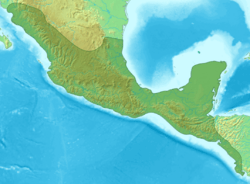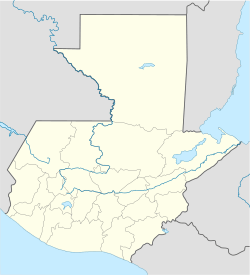Nakbe facts for kids

Temple at Nakbe
|
|
| Location | Petén Department, Guatemala |
|---|---|
| Region | Petén Basin |
| Coordinates | 17°40′58.08″N 89°49′59.16″W / 17.6828000°N 89.8331000°W |
| Type | Settlement |
| History | |
| Periods | Early Preclassic to Late Preclassic |
| Cultures | Maya civilization |
| Site notes | |
| Condition | In ruins |
Nakbe is one of the largest and oldest Maya archaeological sites. It is found in the Mirador Basin in the Petén region of Guatemala. Nakbe is about 13 kilometers (8 miles) south of the even larger Maya city of El Mirador.
Archaeologists believe people started living at Nakbe around 1400 BC. It grew into a big city and stayed important until it declined between 100 and 200 CE. Nakbe and El Mirador both saw their power fade around the same time.
Contents
Discovering and Exploring Nakbe
Nakbe was first seen in 1930 through aerial photos of the area. But serious digging didn't start until 1962. Archaeologist Ian Graham began the first excavations. However, most of the work happened in the 1980s and 1990s. This was thanks to a team from UCLA and the Institute of Anthropology and History of Guatemala.
Their combined efforts led to the RAINPEG Project. This project was led by Dr. Richard D. Hansen. A main goal of the RAINPEG Project was to study the limestone quarries near Nakbe. Limestone was a very important material for building the huge Maya temples.
The RAINPEG Project spent a lot of time studying the tools used to dig out and prepare limestone. They found 23 tools, including axes, picks, and hammer stones. All these tools were made from a hard rock called chert. Researchers then made copies of these tools. They used them to understand how the Maya mined and shaped the limestone. They learned that chert was great for cutting limestone precisely. These experiments showed how the Maya not only got the limestone but also shaped it for their amazing buildings.
Amazing Finds at Nakbe
Archaeologists found many ancient items at the center of Nakbe. These included lots of ceramic pottery from the Middle Preclassic period. Some pots were red and cream, others were multi-colored bowls. They also found jars with narrow openings but no necks, called tecomates. Many small pieces of figurines showing humans and animals were also discovered.
Shells with holes ground through them were common finds. Many were Strombus shells. These shells were a special type of artifact from the early Middle Preclassic period. They were found at Nakbe, Uaxactun, Tikal, and other sites from that time.
These shells show that people in the Maya interior started trading for goods very early. Richard Hansen believes these and other special items, like jade and obsidian, were very important. Obsidian is a volcanic glass used to make sharp tools. The demand for these materials, mostly from Kaminaljuyú in Guatemala's Central Highlands, helped society become more complex. Getting and moving these goods might have led to the need for leaders and governments. This could have happened earlier in this region than in places where these goods were easier to find.
There is also clear evidence of social differences. Archaeologists found human teeth with small jade-like stones set into them. These teeth date back about 2,800 years. Such dental decorations were known to be a sign of high status among Maya leaders later on. Also, a ceramic piece from the Middle Preclassic period showed a profile of a person. This person had a sloping forehead, which was a common feature of later Maya elite society. This shape was created by binding the head when a person was a baby.
Grand Buildings of Nakbe
Nakbe had huge buildings as early as 800 BC. Some platforms were as tall as 18 meters (59 feet). Around 1200 BC, smaller villages were flattened and filled in. This made a base for new, large buildings. This shows that building platforms and huge structures was a planned event.
Nakbe has many buildings, divided into three groups: East, West, and Codex. The East and West groups were built during the early periods. The Codex group was built later when people returned to the site.
The most impressive building at Nakbe is a pyramid called Structure 1. It has two large stucco masks on its sides. On top, it has three structures with roofs in a triadic style. Structure 1 is both grand and beautiful.
The Maya also built special raised roads called causeways to connect their buildings. These causeways were paved with crushed white stone. This is why the Maya called them sacbe, meaning "white way." The Kan Causeway at Nakbe was 4 meters (13 feet) higher than the ground in some places. One causeway even connected Nakbe to the city of El Mirador. Later, in the Late Classic Maya period, Nakbe was also connected to Calakmul. Other sites were linked by this network of sacbeob, which stretched for many kilometers.
Religion and Art at Nakbe
Nakbe Stela 1 is a tall stone monument that was broken into 45 pieces a long time ago. When put back together, it shows two people standing face to face. They are dressed in very old Maya costumes. One figure points upwards to a floating head. This scene is thought to be a story from the Popol Vuh, a sacred Maya book. The famous Princeton Vase, which was found illegally, also shows scenes from the Popol Vuh. It likely came from the Nakbe area.
Why Nakbe Declined
Even though Nakbe has remains from almost every period of Maya history, it stopped being a major center after the early Late Preclassic period. The last big pyramids at Nakbe were built around this time. There are not many Late Preclassic artifacts found at Nakbe. This might be because the nearby city of El Mirador grew very quickly and became more powerful.
Nakbe was mostly empty for about a thousand years. Then, some Late Classic Maya people came back and lived among the ruins. They set up small communities and left behind some beautiful Classic ceramics, like the Princeton Vase. However, they did not build any new monuments of their own.
Images for kids
See also
 In Spanish: Nakbé para niños
In Spanish: Nakbé para niños






